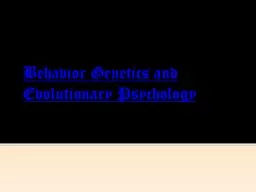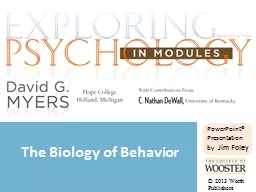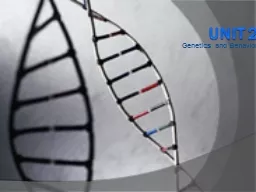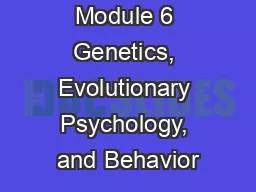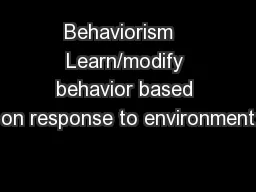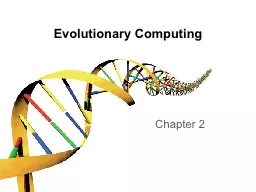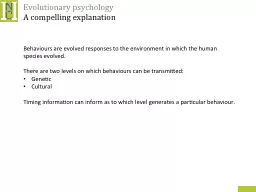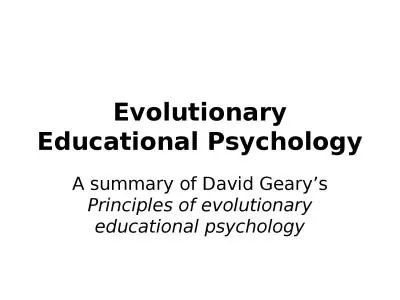PPT-Behavior Genetics and Evolutionary Psychology
Author : lastinsetp | Published Date : 2020-06-17
1 Behavior Genetics and Evolutionary Psychology Behavior Genetics Predicting Individual Differences Genes Our Codes for Life Twin and Adoption Studies Temperament
Presentation Embed Code
Download Presentation
Download Presentation The PPT/PDF document "Behavior Genetics and Evolutionary Psych..." is the property of its rightful owner. Permission is granted to download and print the materials on this website for personal, non-commercial use only, and to display it on your personal computer provided you do not modify the materials and that you retain all copyright notices contained in the materials. By downloading content from our website, you accept the terms of this agreement.
Behavior Genetics and Evolutionary Psychology: Transcript
1 Behavior Genetics and Evolutionary Psychology Behavior Genetics Predicting Individual Differences Genes Our Codes for Life Twin and Adoption Studies Temperament and Heredity Nature and Nurture. The NATURE. in the Nature vs. Nurture conundrum . Principles That define this level of analysis . Biological psychologists use the “Reductionist Approach”. They attempt to explain behavior very simply …. By finding the physiological (physical) reasons behind the behavior. Chapter 1 Section 2. Where did the scientific method . come from?. Wilhelm Wundt. 1879. Leipzig, . Germany. First psychology laboratory . Claims: psychology has 2 elements (sensations and feelings). Procedure used: “introspection”. & Approaches. (2-4%) . . Where do you stand? . How . much is Psychology a real science like Physics, Chemistry or Biology. ?. How much of Psychology’s facts . can . be trusted if every human is different? . . by . Jim Foley. The Biology of Behavior. © 2013 Worth Publishers . Module . 5: Genetics. , Evolutionary Psychology, and Behavior . Topics we were born to learn about. Behavior Genetics and Individual Differences. Genetics and Behavior. Behavior Geneticists. study our differences and weigh the relative effects of heredity and environment.. Chromosomes, Genes, and DNA. Chromosomes. . (46 in each sell) containing . 6-1: . WHAT ARE . CHROMOSOMES, DNA, GENES. , AND THE HUMAN . GENOME. ? HOW DO BEHAVIOR GENETICISTS EXPLAIN OUR INDIVIDUAL DIFFERENCES?. Environment: . Every nongenetic influence, from prenatal nutrition to the people and things around us . Ivan Pavlov (1849-1936) & Classical Conditioning . (The Dog Dude) . John Watson (1878-1958). Behaviorism. Psychology as the science of behavior! . Little Albert Experiment. Classical Conditioning . Cognitive. Social. Personality. Learning. Perception. 2. I believe people choose to live meaningful lives. I share many of the same beliefs as Carl Rogers. Most important, I believe many people have the ability to reach self-actualization. Who am I?. Evo. . Psyc. is the application of Darwinian principles to the understanding of human nature.. . To understand how Darwinian principles are applied to humans one must first understand a number of concepts and premises upon which . .. Perspectives. Psychoanalytic. Behaviorism. Humanism. Cognitive. Evolutionary. Biological/Biomedical. Psychodynamic. The psychodynamic perspective originated with the work of Sigmund Freud. This perspective emphasizes the role of the . Chapter. 2: . Evolutionary. Computing: the . Origins. Historical perspective. Biological inspiration:. Darwinian evolution theory . (simplified!). Genetics . (simplified!). Motivation for EC . 2. What is psychology?. Psychology. is the scientific, systematic study of behavior and mental processes in both humans and animals. It uses the scientific method to ask and answer questions about why people think, act, and feel as they do. Behavior. Behaviours are evolved responses to the environment in which the human species evolved.. There are two levels on which behaviours can be transmitted:. Genetic. Cultural. Timing information can inform as to which level generates a particular behaviour.. A summary of David Geary’s . Principles of evolutionary educational psychology. Principles of Educational Evolutionary Psychology. Secondary knowledge has grown out of folk knowledge. There is a gap between secondary knowledge and folk knowledge.
Download Document
Here is the link to download the presentation.
"Behavior Genetics and Evolutionary Psychology"The content belongs to its owner. You may download and print it for personal use, without modification, and keep all copyright notices. By downloading, you agree to these terms.
Related Documents

